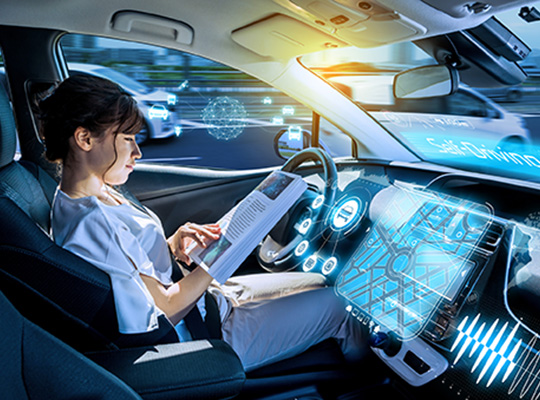Autonomous Vehicles: The Future of Vehicles 24
Autonomous Vehicles
Advanced driver assistance systems (ADAS) and self-driving automobiles are at the forefront of the constantly changing transportation landscape. With the promise of greater safety, effectiveness, and convenience, these inventions are revolutionizing the way we travel on our highways. The broad reach of this revolution is reflected in the increasing use of terminology like intelligent transportation systems, robotic mobility, and vehicle automation as technology develops.
At the core of these advancements is autonomous driving software, which allows cars to function autonomously and lessens the need for human interaction. This blog will examine the many aspects, advantages, and concerns surrounding driverless technology.

We will give a thorough review of this innovative sector, including everything from comprehending how these systems operate to possible obstacles and future opportunities.
A car that can drive itself and carry out essential tasks without assistance from a human is referred to as an autonomous vehicle, or driverless vehicle. The vehicle can sense its surroundings and make decisions in real time thanks to a complex system that powers this innovative technology. Let us examine the technology that powers these cars in more detail.
Follow our Digiknowledge.co.in page for the latest updates about technology, bikes, cars, sports, lifestyle, and many more.
The Technology Behind Autonomous Vehicles
Perception and Sensory Information
Numerous sensors in autonomous cars are used to collect environmental data. These sensors consist of:
Cameras: By taking pictures and films of the environment, these offer visual information. Their significance lies in their ability to identify traffic signs, signals, lane markings, and obstructions.
Radar: Radar systems detect objects and calculate their distance and speed using radio waves. When bad weather is present and vision may be impaired, they work especially well.
Lidar: Using laser pulses, Lidar (Light Detection and Ranging) generates precise, three-dimensional maps of the surroundings. This aids in determining the dimensions and form of items.
Ultrasonic sensors are often employed in parking systems to identify items in close proximity. They are useful for short-range detection.
Data Analysis and Decision-Making
The vehicle’s internal computer uses sophisticated algorithms and artificial intelligence (AI) to process the data that the sensors have collected. Here’s how this procedure operates:
Data Fusion: A thorough understanding of the environment is produced by combining data from several sensors. This procedure, called sensor fusion, improves the information’s accuracy.
Detection and classification of items: Artificial intelligence systems examine the combined data to identify and categorize things, including bicycles, people, cars, and roadblocks.
Path Planning: Using the destination and the items it has spotted as a guide, the vehicle’s system creates a safe and effective route. This entails figuring out the optimal path while accounting for traffic, weather, and any possible dangers.
Control systems: These systems carry out the AI’s driving judgments by directing the car’s braking, acceleration, and steering to stay on the intended course.
Degrees of Automation
From Level 0 (no automation) to Level 5 (complete automation), the Society of Automotive Engineers (SAE) has established six levels of vehicle automation:
Level 0: Complete manual control by the driver; no automation.
Adaptive cruise control and lane-keeping assistance are examples of Level 1 driver assistance technology.
Level 2: Partial automation; steering and acceleration/deceleration are controlled by the car, but the driver has to pay attention.
Conditional automation, or Level 3, requires the driver to be on hand to take over when necessary, although the car can do the majority of driving duties.
Level4: High automation; in some situations or settings, the car can run without the need for human interaction.
Level 5: Complete automation, meaning that no human interaction is required for the car to perform any driving function under any circumstance.
Advantages and Problems
Benefits
Safety: Autonomous cars can dramatically lower the number of accidents brought on by human error, such as driving when intoxicated, distracted, or fatigued.
Efficiency: These cars can enhance fuel economy, lessen traffic, and optimize driving habits.
Accessibility: People who are unable to drive, such as the elderly or the disabled, can find mobility options with autonomous vehicles.
Obstacles
Technical Restrictions: Creating dependable and strong systems that can manage intricate and erratic driving situations is a big task.
Ethical and Legal Issues: Making decisions in life-threatening circumstances and determining who is responsible for an accident provide ethical and legal
Challenges.
Population approval: The broad use of autonomous cars depends on gaining the confidence and approval of the general population.
When will autonomous vehicles be widely used?
A: It is hard to pinpoint a certain date, but experts think that as laws and technology advance over the next ten years, broad acceptance may occur.
Are self-driving cars safe?
Although autonomous vehicles hold promise for increased safety compared to human-driven automobiles, there are concerns involved. These issues are being addressed through ongoing development and testing.
What happens if a self-driving car gets into an accident?
Self-driving automobile accidents provide a complicated liability situation. Factors such as the degree of automation, accident conditions, and relevant legislation could influence this.
Will the necessity for human drivers be eliminated by self-driving cars?
Although completely autonomous vehicles have the potential to eliminate the need for human drivers, there will probably always be situations in which human assistance is required or desirable.
What are the benefits of AVs?
Automatic vehicles (AVs) have the potential to enhance traffic efficiency, expand road capacity, and lessen gridlock. Additionally, they are able to select shorter routes, which increases driving efficiency and saves energy. In addition to lowering fatalities and human error, autonomous vehicles have the potential to minimize crashes by 90%.
What are the pillars of autonomous driving?
The four main components of autonomous vehicles are control, perception, localization, and planning.
Why do people want autonomous driving?
According to government statistics, driver error or behavior accounts for 94% of crashes; self-driving cars can lessen driver error. Increased degrees of autonomy may discourage reckless and hazardous driving practices.




